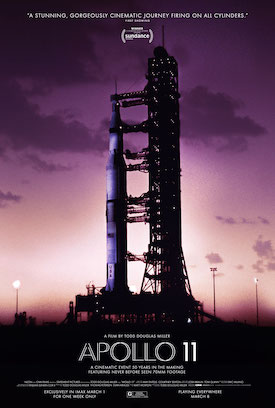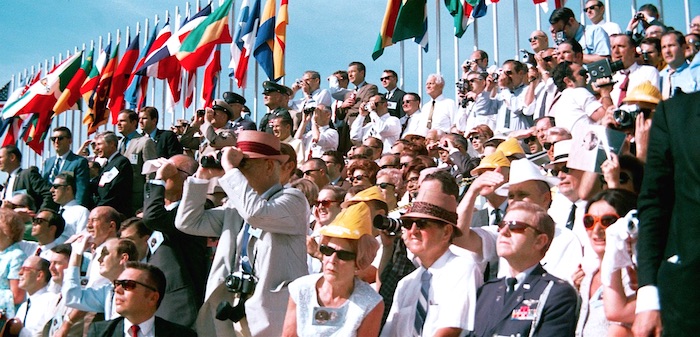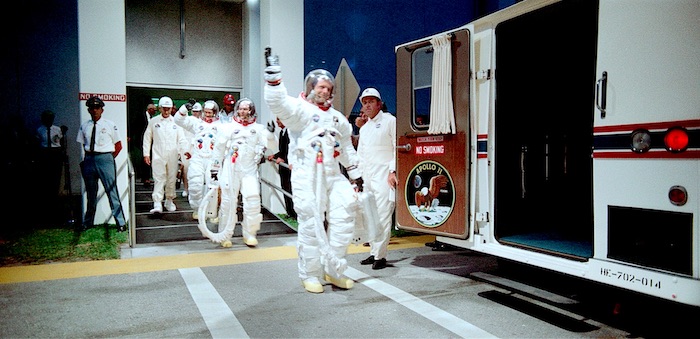 From director Todd Douglas Miller (Dinosaur 13) comes a cinematic event 50 years in the making. Crafted from a newly discovered trove of 65mm footage, and more than 11,000 hours of uncatalogued audio recordings, Apollo 11 takes us straight to the heart of NASA’s most celebrated mission — the one that first put men on the moon, and forever made Neil Armstrong and Buzz Aldrin into household names. Immersed in the perspectives of the astronauts, the team in Mission Control, and the millions of spectators on the ground, we vividly experience those momentous days and hours in 1969 when humankind took a giant leap into the future. I spoke to Todd Douglas Miller about this riveting widescreen look at one of the most remarkable achievements in human history.
From director Todd Douglas Miller (Dinosaur 13) comes a cinematic event 50 years in the making. Crafted from a newly discovered trove of 65mm footage, and more than 11,000 hours of uncatalogued audio recordings, Apollo 11 takes us straight to the heart of NASA’s most celebrated mission — the one that first put men on the moon, and forever made Neil Armstrong and Buzz Aldrin into household names. Immersed in the perspectives of the astronauts, the team in Mission Control, and the millions of spectators on the ground, we vividly experience those momentous days and hours in 1969 when humankind took a giant leap into the future. I spoke to Todd Douglas Miller about this riveting widescreen look at one of the most remarkable achievements in human history.
Danny Miller: What an extraordinary film! I’m old enough to have vivid memories of watching the Apollo 11 moon landing when I was a kid. I remember running out into the street that night to look at the moon and see if I could see the astronauts. I thought I was familiar with most of the images from that time period but was flabbergasted at what you show in this film. Where has all of this amazing footage been all these years?
Todd Douglas Miller: Initially, our goal was to rescan all of the existing 16 and 35mm footage, we didn’t even know the large-format stuff existed. I wouldn’t say we “discovered” any of it, it’s more like we rediscovered these hundreds of reels of 65mm footage. Of course, that footage has been there the whole time but the technology to be able to rescan it is much more recent.
Has it ever been seen before by the public?
There was a film made back then called Moonwalk One that was released in 1970 when people were pretty saturated with the space program but it later became a kind of cult classic among space nerds and the space community. It was shot by these great cinematographers, Urs Furrer and Hideaki Kobaeashi, along with some other people, including all those shots during the launch of those faces in the crowd. We used some of the footage from that film. When we first started this project, we were going to do it in 4K. I remember we were at a meeting in New York when someone turned to me and said, “You know, if we wait about six months, we can do it in 16K.” The technology was changing that fast. I didn’t want to look back 20 years from now and say that we didn’t take advantage of that opportunity so we waited. Of course, the six months turned into seven, eight, and nine but I’m so glad we waited. For us, the work was partly about making this film and introducing new audiences to this incredible story, and partly about preserving and curating all of these materials for future generations. It’s really become a giant preservation project.
Seeing the large-format stuff is just incredible.
I’ve always been a big fan of large-format films from the 1950s and 60s which are tough to find nowadays. There was one particular company, Francis Thompson, that was shooting a lot of large-format film back then. They did a film called To Be Alive for the 1964 New York World’s Fair which ended up winning an Oscar. And those are the people who ended up working on Moonwalk One. We also used some footage from a fantastic little film called Bridge to Space.

The footage of the launch is just astounding to see in this way.
That was actually taken from a motorized remote control camera. They had rehearsed that with Apollo 9 and 10 and they kept missing it, but they nailed it on Apollo 11.
It’s so great that all of this footage is now restored for posterity. I can imagine what a huge editing task you had with all that footage. How did you decide what to include?
We started with nine days of footage and audio and transcribed everything and put it in a timeline. That obviously took a really long time. Then we just started looking for moments that hadn’t really been represented before. We read all of the books and autobiographies we could find of people who were there. Astronaut Mike Collins’ book, Carrying the Fire, was a great resource, it’s so well written and very witty and insightful. That gave us ideas for some of the things we wanted to put into the film. We worked with him and Buzz Aldrin and Neil Armstrong’s kids. Armstrong gave some interviews where he talked about some of the most iconic parts of the mission for him. They weren’t necessarily when he put his foot down on the lunar surface or even returning to earth safely, for him it was seeing the moon during the solar eclipse that was happening and how the moon appeared three-dimensional for the first time. There were lots of things we showed that hadn’t been depicted before in a film.
Were they any things you would have liked to include that you just couldn’t find room for?
We always wanted to highlight some of the people that were not that well known who had very important jobs. There was an African American man I’d always seen in the background who was in the spacecraft analysis room. He had a very important job which was to analyze the radiation that the astronauts were getting during the mission. Every night, the astronauts would radio back their radiation levels and his job was to analyze all that. He and his team were also tracking solar flares so that they could get warnings to the spacecraft to deflect them if necessary since that could greatly increase the radiation that the astronauts were exposed to. There was also this 25-year-old mathematician named Poppy Northcutt who was smart as a tack. During the journey home, some of the guys at mission control were struggling with the math and the trajectories weren’t lining up, it was purely a mathematical issue but way above most people’s heads. And then Poppy gets on the intercom with them and she read them the riot act. Unfortunately, we couldn’t find enough footage of those people to make it work for the film but I hope we can find ways to include some of that other stuff.
I liked the use of the Walter Cronkite audio, that was so effective.
There were only a few places where I wanted to use it. He was pretty incredible — nothing was prepared in advance for Cronkite, everything he said was in the moment. We had these shots of the astronauts suiting up from the dry run three days earlier when they were joking and smiling and then when they’re doing that on the day of the smiles are gone and you feel like you can see the weight of the world on their shoulders. I remember watching that juxtaposition without sound and our jaws were on the floor, but then I had Cronkite in my head remembering what he had said about those guys the morning of the launch and I really wanted to marry those images and Cronkite’s words.

Watching this film, there were several times when I just burst into tears, I found it such a moving experience. I was trying to figure out why — was it just the sheer accomplishment of it all? Or maybe the feeling, as even President Nixon talks about, that this was one of the few times in history when the whole world was united for a common goal? Did you ever have that emotional reaction watching the film?
You know, it’s funny — usually, when I make a film I watch it once or twice after it’s completed. I like to edit my own stuff, so by the time it’s pieced together I’ve seen it so many times that I don’t need to see it again. But with this film, I went to every single screening at Sundance, and I’ve been at many other showings since then, I just can’t get enough of it! I watch it all the time and I get something new from it every single time. And I do get very emotional. Every time at the end of the film when I hear President Kennedy talking about his hope to get a man on the moon before the end of the decade, and I think of the sheer magnitude of what was accomplished by these men and women — you just can’t help but be emotionally connected to that.
Would you like to see another manned space program in this country?
Yes, I hope so. First of all, from a practical standpoint, I don’t think we’re going to be here forever, eventually we’re going to have to spread our wings into the universe. But thinking about what’s going on now in this country and all over the world, I just think that humanity needs these types of things. We need to be reminded that we can work together to do something extraordinary.

